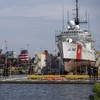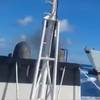Advances in steel processing have enabled shipyards around the globe to streamline operations while vastly improving efficiency and quality. This fact is not lost on the shipyards of the Gulf of Mexico region, which in recent years have invested tens of millions of dollars in advanced systems designed to propel their yards into world class levels of quality and efficiency.
Bender: Breaking out of the “Second Tier” Image
Bender Shipbuilding’s transformation from a so-called “second tier” shipyard into a world-class facility is hinged on the success of its newly opened First Operations Shop. The new facility, which features the installation of a high powered laser cutting machine, will include operations such as raw plate and profile receipt and storage, blasting and primer painting plate and profiles, plate cutting, part forming, profile cutting and forming, part identification, part kitting, and delivery of kitted parts to downstream processes.
Prior to the First Operations Shop, Bender had no in-house plate cutting capability. In selecting the laser system, Bender has effectively postioned itself to prosper for many years to come. Bender can attribute part of the success of opening the new shop with its collaborations with Caterpillar, which though a Maritech project, provided Bender with a full set of technical data which was key in ascertaining Bender’s needs in terms of quality and speed. In addition, Caterpillar transferred a proprietary technology of tab & slot and twist tab joing designs to Bender Shipbuilding, a technology which is enabled by the precision and cut quality of the laser. Bender tabs the technology as a significant enhancement to the way in which ships are designed and built, and the concept was presented to ABS for strength and fatigue tests. The results were successful, and now Bender will petition ABS to formally approve the joint design and allow its use in selected applications.
To investigate which cutting solution would be best for Bender, executives embarked on an international tour of yards in Europe and Asia, as well as ship and boatyards in the U.S., such as Bath Iron Works, Friede Goldman, Alabama shipyard, Avondale, Halter Pascagoula, Halter Equitable and Bollinger. Bender’s First Operations Shop — which at press time was scheduled to open with full functionality at the beginning of 2000 — represents the latest advances in materials processing, as well as laser cutting. According to the company, the 6 kW laser system to be installed offers many quality advantages, including an accuracy withing .004-in. In addition, part repeatability is nearly 100 percent, and there is no degradation of the beam quality over the course of the cutting program between normal, routine maintenance.
Steiner Steps Up
Steiner Shipyard, with origins as a family shipyard dating back to the 1920s, is certainly a well-known and regarded entity in the local maritime markets. However, Steiner is far more than a local player, as it counts companies around the globe, including Japan, as good customers in standing.
Steiner is perhaps best known for its endeavors in the fishing vessel markets, as it has built hundreds of boats over the years. But the company’s activities are broadly stretched, a strategy, which has yielded dividends as cyclical trends on occasion touch one or more of the branches. The latest business opportunity for Steiner revolves around a new company dubbed Enviro-Metals. Featuring a Wheelabrator metal processing unit, used to preblast millscale (the coating on metals that must be removed before the metal can be painted). The unit is housed in its own building, which is a great benefit toward complying with EPA guidelines. In fact, Russell says, the Alabama Conservation Department has even issued tickets if sand goes into the water during the blasting process — a far more likely result for yards still blasting in open air.
The tighter regulations on blasting and coating mean small boatyards need to employ such a process; however, the prohibitive cost of the unit makes the prospect a bit unfeasible. Therefore, Steiner's hope is to offer the company's services to local, smaller shipyards.
"We'll do it all," Russell says, "we'll cut, blast, prepare the metal. All the shipyard will have to do is assemble the hull." Steiner is no stranger to such an arrangement, as the company already subs out some expertise work of its own. With only 100 manufacturing employees, such tasks as electrical work, carpentry, refrigeration and electronics are among the jobs subbed out to local businesses.
Sponsored Content
MSC Sets a New Standard for Time Off in 2025, Plus Earn a $44,345 Bonus as an Able Seaman!

The Future of the Advanced Measurement Industry: A Vision of Precision, Safety, and Reliability

August 2025
 Read the Magazine
Read the Magazine

 Read the Magazine
Read the Magazine
This issue sponsored by:

Washington Watch – Water Carrier Statutes & Regulations
Subscribe for
Maritime Reporter E-News
Maritime Reporter E-News is the maritime industry's largest circulation and most authoritative ENews Service, delivered to your Email five times per week









